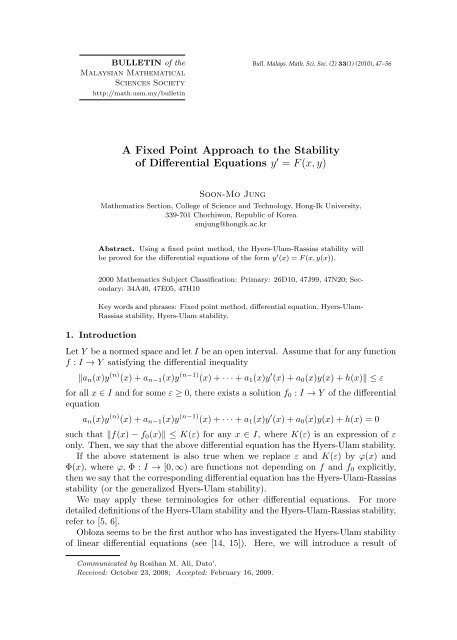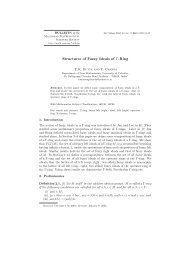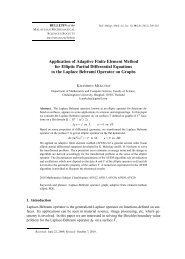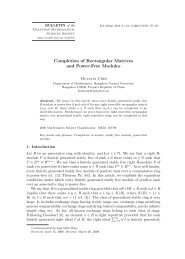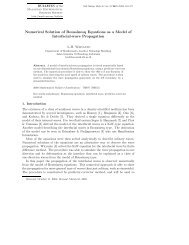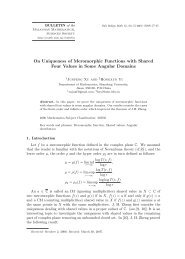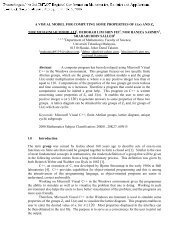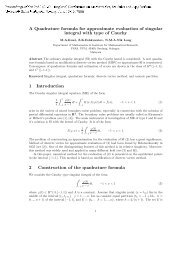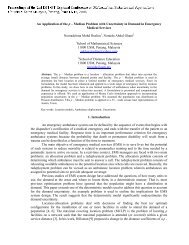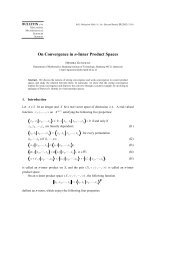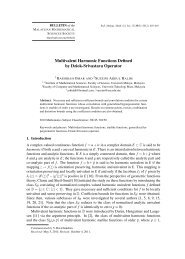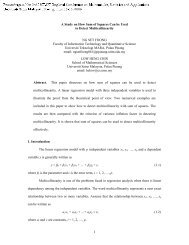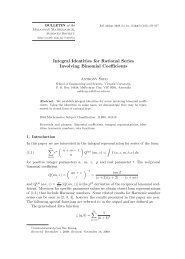A Fixed Point Approach to the Stability of Differential Equations y ...
A Fixed Point Approach to the Stability of Differential Equations y ...
A Fixed Point Approach to the Stability of Differential Equations y ...
You also want an ePaper? Increase the reach of your titles
YUMPU automatically turns print PDFs into web optimized ePapers that Google loves.
BULLETIN <strong>of</strong> <strong>the</strong><br />
Malaysian Ma<strong>the</strong>matical<br />
Sciences Society<br />
http://math.usm.my/bulletin<br />
Bull. Malays. Math. Sci. Soc. (2) 33(1) (2010), 47–56<br />
A <strong>Fixed</strong> <strong>Point</strong> <strong>Approach</strong> <strong>to</strong> <strong>the</strong> <strong>Stability</strong><br />
<strong>of</strong> <strong>Differential</strong> <strong>Equations</strong> y ′ = F (x, y)<br />
Soon-Mo Jung<br />
Ma<strong>the</strong>matics Section, College <strong>of</strong> Science and Technology, Hong-Ik University,<br />
339-701 Chochiwon, Republic <strong>of</strong> Korea<br />
smjung@hongik.ac.kr<br />
Abstract. Using a fixed point method, <strong>the</strong> Hyers-Ulam-Rassias stability will<br />
be proved for <strong>the</strong> differential equations <strong>of</strong> <strong>the</strong> form y ′ (x) = F (x, y(x)).<br />
2000 Ma<strong>the</strong>matics Subject Classification: Primary: 26D10, 47J99, 47N20; Secondary:<br />
34A40, 47E05, 47H10<br />
Key words and phrases: <strong>Fixed</strong> point method, differential equation, Hyers-Ulam-<br />
Rassias stability, Hyers-Ulam stability.<br />
1. Introduction<br />
Let Y be a normed space and let I be an open interval. Assume that for any function<br />
f : I → Y satisfying <strong>the</strong> differential inequality<br />
an(x)y (n) (x) + an−1(x)y (n−1) (x) + · · · + a1(x)y ′ (x) + a0(x)y(x) + h(x) ≤ ε<br />
for all x ∈ I and for some ε ≥ 0, <strong>the</strong>re exists a solution f0 : I → Y <strong>of</strong> <strong>the</strong> differential<br />
equation<br />
an(x)y (n) (x) + an−1(x)y (n−1) (x) + · · · + a1(x)y ′ (x) + a0(x)y(x) + h(x) = 0<br />
such that f(x) − f0(x) ≤ K(ε) for any x ∈ I, where K(ε) is an expression <strong>of</strong> ε<br />
only. Then, we say that <strong>the</strong> above differential equation has <strong>the</strong> Hyers-Ulam stability.<br />
If <strong>the</strong> above statement is also true when we replace ε and K(ε) by ϕ(x) and<br />
Φ(x), where ϕ, Φ : I → [0, ∞) are functions not depending on f and f0 explicitly,<br />
<strong>the</strong>n we say that <strong>the</strong> corresponding differential equation has <strong>the</strong> Hyers-Ulam-Rassias<br />
stability (or <strong>the</strong> generalized Hyers-Ulam stability).<br />
We may apply <strong>the</strong>se terminologies for o<strong>the</strong>r differential equations. For more<br />
detailed definitions <strong>of</strong> <strong>the</strong> Hyers-Ulam stability and <strong>the</strong> Hyers-Ulam-Rassias stability,<br />
refer <strong>to</strong> [5, 6].<br />
Ob̷loza seems <strong>to</strong> be <strong>the</strong> first author who has investigated <strong>the</strong> Hyers-Ulam stability<br />
<strong>of</strong> linear differential equations (see [14, 15]). Here, we will introduce a result <strong>of</strong><br />
Communicated by Rosihan M. Ali, Da<strong>to</strong>’.<br />
Received: Oc<strong>to</strong>ber 23, 2008; Accepted: February 16, 2009.
48 S.-M. Jung<br />
Alsina and Ger (see [1]): If a differentiable function f : I → R is a solution <strong>of</strong> <strong>the</strong><br />
differential inequality |y ′ (x) − y(x)| ≤ ε, where I is an open subinterval <strong>of</strong> R, <strong>the</strong>n<br />
<strong>the</strong>re exists a solution f0 : I → R <strong>of</strong> <strong>the</strong> differential equation y ′ (x) = y(x) such that<br />
|f(x) − f0(x)| ≤ 3ε for any x ∈ I.<br />
This result <strong>of</strong> Alsina and Ger has been generalized by Takahasi, Miura and Miyajima:<br />
They proved in [17] that <strong>the</strong> Hyers-Ulam stability holds for <strong>the</strong> Banach space<br />
valued differential equation y ′ (x) = λy(x) (see also [11]).<br />
Recently, Miura, Miyajima and Takahasi also proved <strong>the</strong> Hyers-Ulam stability<br />
<strong>of</strong> linear differential equations <strong>of</strong> first order, y ′ (x) + g(x)y(x) = 0, where g(x) is<br />
a continuous function, while <strong>the</strong> author proved <strong>the</strong> Hyers-Ulam stability <strong>of</strong> linear<br />
differential equations <strong>of</strong> o<strong>the</strong>r type (see [7, 8, 9, 12, 13]).<br />
In this paper, for a bounded and continuous function F (x, y), we will adopt <strong>the</strong><br />
idea <strong>of</strong> Cădariu and Radu [2, 3] and prove <strong>the</strong> Hyers-Ulam-Rassias stability as well<br />
as <strong>the</strong> Hyers-Ulam stability <strong>of</strong> <strong>the</strong> differential equations <strong>of</strong> <strong>the</strong> form<br />
(1.1) y ′ (x) = F (x, y(x)).<br />
2. Preliminaries<br />
For a nonempty set X, we introduce <strong>the</strong> definition <strong>of</strong> <strong>the</strong> generalized metric on X.<br />
A function d : X × X → [0, ∞] is called a generalized metric on X if and only if d<br />
satisfies<br />
(M1) d(x, y) = 0 if and only if x = y;<br />
(M2) d(x, y) = d(y, x) for all x, y ∈ X;<br />
(M3) d(x, z) ≤ d(x, y) + d(y, z) for all x, y, z ∈ X.<br />
We remark that <strong>the</strong> only one difference <strong>of</strong> <strong>the</strong> generalized metric from <strong>the</strong> usual<br />
metric is that <strong>the</strong> range <strong>of</strong> <strong>the</strong> former is permitted <strong>to</strong> include <strong>the</strong> infinity.<br />
We now introduce one <strong>of</strong> fundamental results <strong>of</strong> fixed point <strong>the</strong>ory. For <strong>the</strong><br />
pro<strong>of</strong>, we refer <strong>to</strong> [4]. This <strong>the</strong>orem will play an important rôle in proving our main<br />
<strong>the</strong>orems.<br />
Theorem 2.1. Let (X, d) be a generalized complete metric space. Assume that<br />
Λ : X → X is a strictly contractive opera<strong>to</strong>r with <strong>the</strong> Lipschitz constant L < 1. If<br />
<strong>the</strong>re exists a nonnegative integer k such that d(Λ k+1 x, Λ k x) < ∞ for some x ∈ X,<br />
<strong>the</strong>n <strong>the</strong> followings are true:<br />
(a) The sequence {Λ n x} converges <strong>to</strong> a fixed point x ∗ <strong>of</strong> Λ;<br />
(b) x ∗ is <strong>the</strong> unique fixed point <strong>of</strong> Λ in<br />
(c) If y ∈ X ∗ , <strong>the</strong>n<br />
3. Hyers-Ulam-Rassias stability<br />
X ∗ = {y ∈ X | d(Λ k x, y) < ∞} ;<br />
d(y, x ∗ ) ≤ 1<br />
d(Λy, y).<br />
1 − L<br />
Recently, Cădariu and Radu [2] applied <strong>the</strong> fixed point method <strong>to</strong> <strong>the</strong> investigation<br />
<strong>of</strong> <strong>the</strong> Jensen’s functional equation. Using such an idea, <strong>the</strong>y could present a pro<strong>of</strong><br />
for <strong>the</strong> Hyers-Ulam stability <strong>of</strong> that equation (ref. [3, 10, 16]).
A <strong>Fixed</strong> <strong>Point</strong> <strong>Approach</strong> <strong>to</strong> <strong>the</strong> <strong>Stability</strong> <strong>of</strong> <strong>Differential</strong> <strong>Equations</strong> 49<br />
In this section, by using <strong>the</strong> idea <strong>of</strong> Cădariu and Radu, we will prove <strong>the</strong> Hyers-<br />
Ulam-Rassias stability <strong>of</strong> <strong>the</strong> differential equation (1.1).<br />
Theorem 3.1. For given real numbers a and b with a < b, let I = [a, b] be a closed<br />
interval and choose a c ∈ I. Let K and L be positive constants with 0 < KL < 1.<br />
Assume that F : I × R → R is a continuous function which satisfies a Lipschitz<br />
condition<br />
(3.1) |F (x, y) − F (x, z)| ≤ L|y − z|<br />
for any x ∈ I and y, z ∈ R. If a continuously differentiable function y : I → R<br />
satisfies<br />
(3.2) |y ′ (x) − F (x, y(x))| ≤ ϕ(x)<br />
for all x ∈ I, where ϕ : I → (0, ∞) is a continuous function with<br />
<br />
x <br />
<br />
(3.3)<br />
<br />
ϕ(τ) dτ<br />
≤ Kϕ(x)<br />
c<br />
for each x ∈ I, <strong>the</strong>n <strong>the</strong>re exists a unique continuous function y0 : I → R such that<br />
(3.4) y0(x) = y(c) +<br />
x<br />
(consequently, y0 is a solution <strong>to</strong> (1.1)) and<br />
c<br />
F (τ, y0(τ)) dτ<br />
(3.5) |y(x) − y0(x)| ≤ K<br />
1 − KL ϕ(x)<br />
for all x ∈ I.<br />
Pro<strong>of</strong>. Let us define a set X <strong>of</strong> all continuous functions f : I → R by<br />
(3.6) X = {f : I → R | f is continuous}<br />
and introduce a generalized metric on X as follows:<br />
(3.7) d(f, g) = inf{C ∈ [0, ∞] | |f(x) − g(x)| ≤ Cϕ(x) ∀ x ∈ I}.<br />
(We will here give a pro<strong>of</strong> for <strong>the</strong> triangle inequality only. Assume that d(f, g) ><br />
d(f, h) + d(h, g) would hold for some f, g, h ∈ X. Then, by (3.7), <strong>the</strong>re would exist<br />
an x0 ∈ I with<br />
|f(x0) − g(x0)| > {d(f, h) + d(h, g)}ϕ(x0)<br />
= d(f, h)ϕ(x0) + d(h, g)ϕ(x0)<br />
≥ |f(x0) − h(x0)| + |h(x0) − g(x0)|,<br />
a contradiction.)<br />
We assert that (X, d) is complete. Let {hn} be a Cauchy sequence in (X, d).<br />
Then, for any ε > 0, <strong>the</strong>re exists an integer Nε > 0 such that d(hm, hn) ≤ ε for all<br />
m, n ≥ Nε. It fur<strong>the</strong>r follows from (3.7) that<br />
(3.8) ∀ ε > 0 ∃ Nε ∈ N ∀ m, n ≥ Nε ∀ x ∈ I : |hm(x) − hn(x)| ≤ εϕ(x).
50 S.-M. Jung<br />
If x is fixed, (3.8) implies that {hn(x)} is a Cauchy sequence in R. Since R is<br />
complete, {hn(x)} converges for each x ∈ I. Thus, we can define a function h : I → R<br />
by<br />
h(x) = lim<br />
n→∞ hn(x).<br />
If we let m increase <strong>to</strong> infinity, it <strong>the</strong>n follows from (3.8) that<br />
(3.9) ∀ ε > 0 ∃ Nε ∈ N ∀ n ≥ Nε ∀ x ∈ I : |h(x) − hn(x)| ≤ εϕ(x),<br />
that is, since ϕ is bounded on I, {hn} converges uniformly <strong>to</strong> h. Hence, h is continuous<br />
and h ∈ X.<br />
Fur<strong>the</strong>r if we consider (3.7) and (3.9), <strong>the</strong>n we may conclude that<br />
∀ ε > 0 ∃ Nε ∈ N ∀ n ≥ Nε : d(h, hn) ≤ ε,<br />
that is, <strong>the</strong> Cauchy sequence {hn} converges <strong>to</strong> h in (X, d). Hence, (X, d) is complete.<br />
Now, an opera<strong>to</strong>r Λ : X → X is defined by<br />
(3.10) (Λf)(x) = y(c) +<br />
x<br />
c<br />
F (τ, f(τ)) dτ (x ∈ I)<br />
for all f ∈ X. (Indeed, according <strong>to</strong> <strong>the</strong> Fundamental Theorem <strong>of</strong> Calculus, Λf is<br />
continuously differentiable on I, since F and f are continuous functions. Hence, we<br />
may conclude that Λf ∈ X.)<br />
We prove that Λ is strictly contractive on X. For any f, g ∈ X, let Cfg ∈ [0, ∞]<br />
be an arbitrary constant with d(f, g) ≤ Cfg, that is, by (3.7), we have<br />
(3.11) |f(x) − g(x)| ≤ Cfgϕ(x)<br />
for any x ∈ I. It <strong>the</strong>n follows from (3.1), (3.3), (3.7), (3.10) and (3.11) that<br />
<br />
x<br />
<br />
<br />
|(Λf)(x) − (Λg)(x)| = <br />
{F (τ, f(τ)) − F (τ, g(τ))} dτ<br />
<br />
c<br />
<br />
x<br />
<br />
<br />
≤ <br />
|F (τ, f(τ)) − F (τ, g(τ))| dτ<br />
<br />
c<br />
<br />
x<br />
<br />
<br />
≤ L <br />
|f(τ) − g(τ)| dτ<br />
<br />
c<br />
<br />
x <br />
<br />
≤ LCfg <br />
ϕ(τ) dτ<br />
<br />
c<br />
≤ KLCfgϕ(x)<br />
for all x ∈ I, that is, d(Λf, Λg) ≤ KLCfg. Hence, we can conclude that d(Λf, Λg) ≤<br />
KLd(f, g) for any f, g ∈ X, where we note that 0 < KL < 1.<br />
It follows from (3.6) and (3.10) that for an arbitrary g0 ∈ X, <strong>the</strong>re exists a<br />
constant 0 < C < ∞ with<br />
<br />
<br />
x<br />
<br />
<br />
|(Λg0)(x) − g0(x)| = <br />
y(c) + F (τ, g0(τ)) dτ − g0(x) <br />
≤ Cϕ(x)<br />
c<br />
for all x ∈ I, since F (x, g0(x)) and g0(x) are bounded on I and minx∈I ϕ(x) > 0.<br />
Thus, (3.7) implies that<br />
d(Λg0, g0) < ∞.
A <strong>Fixed</strong> <strong>Point</strong> <strong>Approach</strong> <strong>to</strong> <strong>the</strong> <strong>Stability</strong> <strong>of</strong> <strong>Differential</strong> <strong>Equations</strong> 51<br />
Therefore, according <strong>to</strong> Theorem 2.1 (a), <strong>the</strong>re exists a continuous function y0 :<br />
I → R such that Λ n g0 → y0 in (X, d) and Λy0 = y0, that is, y0 satisfies equation<br />
(3.4) for every x ∈ I.<br />
We will now verify that {g ∈ X | d(g0, g) < ∞} = X. For any g ∈ X, since g and<br />
g0 are bounded on I and minx∈I ϕ(x) > 0, <strong>the</strong>re exists a constant 0 < Cg < ∞ such<br />
that<br />
|g0(x) − g(x)| ≤ Cgϕ(x)<br />
for any x ∈ I. Hence, we have d(g0, g) < ∞ for all g ∈ X, that is, {g ∈ X | d(g0, g) <<br />
∞} = X. Hence, in view <strong>of</strong> Theorem 2.1 (b), we conclude that y0 is <strong>the</strong> unique<br />
continuous function with <strong>the</strong> property (3.4).<br />
On <strong>the</strong> o<strong>the</strong>r hand, it follows from (3.2) that<br />
−ϕ(x) ≤ y ′ (x) − F (x, y(x)) ≤ ϕ(x)<br />
for all x ∈ I. If we integrate each term in <strong>the</strong> above inequality from c <strong>to</strong> x, <strong>the</strong>n we<br />
obtain <br />
x<br />
<br />
<br />
y(x) − y(c) − F (τ, y(τ)) dτ<br />
≤<br />
<br />
x <br />
<br />
<br />
ϕ(τ) dτ<br />
<br />
for any x ∈ I. Thus, by (3.3) and (3.10), we get<br />
<br />
x <br />
<br />
|y(x) − (Λy)(x)| ≤ <br />
ϕ(τ) dτ<br />
≤ Kϕ(x)<br />
for each x ∈ I, which implies that<br />
(3.12) d(y, Λy) ≤ K.<br />
Finally, Theorem 2.1 (c) <strong>to</strong>ge<strong>the</strong>r with (3.12) implies that<br />
d(y, y0) ≤<br />
c<br />
c<br />
1<br />
d(Λy, y) ≤<br />
1 − KL K<br />
1 − KL ,<br />
which means that <strong>the</strong> inequality (3.5) holds true for all x ∈ I.<br />
In <strong>the</strong> last <strong>the</strong>orem, we have investigated <strong>the</strong> Hyers-Ulam-Rassias stability <strong>of</strong> <strong>the</strong><br />
differential equation (1.1) defined on a bounded and closed interval. We will now<br />
prove <strong>the</strong> <strong>the</strong>orem for <strong>the</strong> case <strong>of</strong> unbounded intervals. More precisely, Theorem 3.1<br />
is also true if I is replaced by an unbounded interval such as (−∞, b], R, or [a, ∞),<br />
as we see in <strong>the</strong> following <strong>the</strong>orem.<br />
Theorem 3.2. For given real numbers a and b, let I denote ei<strong>the</strong>r (−∞, b] or R or<br />
[a, ∞). Set ei<strong>the</strong>r c = a for I = [a, ∞) or c = b for I = (−∞, b] or c is a fixed real<br />
number if I = R. Let K and L be positive constants with 0 < KL < 1. Assume that<br />
F : I × R → R is a continuous function which satisfies a Lipschitz condition (3.1)<br />
for all x ∈ I and all y, z ∈ R. If a continuously differentiable function y : I → R<br />
satisfies <strong>the</strong> differential inequality (3.2) for all x ∈ I, where ϕ : I → (0, ∞) is a<br />
continuous function satisfying <strong>the</strong> condition (3.3) for any x ∈ I, <strong>the</strong>n <strong>the</strong>re exists a<br />
unique continuous function y0 : I → R which satisfies (3.4) and (3.5) for all x ∈ I.<br />
Pro<strong>of</strong>. We will give <strong>the</strong> pro<strong>of</strong> for <strong>the</strong> case I = R only. The o<strong>the</strong>r cases can similarly<br />
be proved.<br />
c
52 S.-M. Jung<br />
For any n ∈ N, we define In = [c−n, c+n]. (We set In = [b−n, b] for I = (−∞, b]<br />
and In = [a, a + n] for I = [a, ∞).) According <strong>to</strong> Theorem 3.1, <strong>the</strong>re exists a unique<br />
continuous function yn : In → R such that<br />
(3.13) yn(x) = y(c) +<br />
and<br />
x<br />
c<br />
F (τ, yn(τ)) dτ<br />
(3.14) |y(x) − yn(x)| ≤ K<br />
1 − KL ϕ(x)<br />
for all x ∈ In. The uniqueness <strong>of</strong> yn implies that if x ∈ In, <strong>the</strong>n<br />
(3.15) yn(x) = yn+1(x) = yn+2(x) = · · · .<br />
For any x ∈ R, let us define n(x) ∈ N as<br />
n(x) = min{n ∈ N | x ∈ In}.<br />
Moreover, we define a function y0 : R → R by<br />
(3.16) y0(x) = y n(x)(x),<br />
and we assert that y0 is continuous. For an arbitrary x1 ∈ R, we choose <strong>the</strong> integer<br />
n1 = n(x1). Then, x1 belongs <strong>to</strong> <strong>the</strong> interior <strong>of</strong> In1+1 and <strong>the</strong>re exists an ε > 0 such<br />
that y0(x) = yn1+1(x) for all x with x1 − ε < x < x1 + ε. Since yn1+1 is continuous<br />
at x1, so is y0. That is, y0 is continuous at x1 for any x1 ∈ R.<br />
We will now show that y0 satisfies (3.4) and (3.5) for all x ∈ R. For an arbitrary<br />
x ∈ R, we choose <strong>the</strong> integer n(x). Then, it holds that x ∈ In(x) and it follows from<br />
(3.13) and (3.16) that<br />
y0(x) = y n(x)(x) = y(c) +<br />
x<br />
c<br />
F (τ, y n(x)(τ)) dτ = y(c) +<br />
x<br />
c<br />
F (τ, y0(τ)) dτ,<br />
where <strong>the</strong> last equality holds true because n(τ) ≤ n(x) for any τ ∈ I n(x) and it<br />
follows from (3.15) and (3.16) that<br />
y n(x)(τ) = y n(τ)(τ) = y0(τ).<br />
Since x ∈ I n(x) for every x ∈ R, by (3.14) and (3.16), we have<br />
|y(x) − y0(x)| = |y(x) − y n(x)(x)| ≤<br />
K<br />
1 − KL ϕ(x)<br />
for any x ∈ R.<br />
Finally, we show that y0 is unique. Let z0 : R → R be ano<strong>the</strong>r continuous function<br />
which satisfies (3.4) and (3.5), with z0 in place <strong>of</strong> y0, for all x ∈ R. Suppose x is<br />
an arbitrary real number. Since <strong>the</strong> restrictions y0| In(x) (= y n(x)) and z0| In(x) both<br />
satisfy (3.4) and (3.5) for all x ∈ I n(x), <strong>the</strong> uniqueness <strong>of</strong> y n(x) = y0| In(x) implies<br />
that<br />
as required.<br />
y0(x) = y0| In(x) (x) = z0| In(x) (x) = z0(x),
4. Hyers-Ulam stability<br />
A <strong>Fixed</strong> <strong>Point</strong> <strong>Approach</strong> <strong>to</strong> <strong>the</strong> <strong>Stability</strong> <strong>of</strong> <strong>Differential</strong> <strong>Equations</strong> 53<br />
In <strong>the</strong> following <strong>the</strong>orem, we prove <strong>the</strong> Hyers-Ulam stability <strong>of</strong> <strong>the</strong> differential equation<br />
(1.1) defined on a finite and closed interval.<br />
Theorem 4.1. Given c ∈ R and r > 0, let I denote a closed ball <strong>of</strong> radius r and<br />
centered at c, that is, I = {x ∈ R | c − r ≤ x ≤ c + r} and let F : I × R → R be<br />
a continuous function which satisfies a Lipschitz condition (3.1) for all x ∈ I and<br />
y, z ∈ R, where L is a constant with 0 < Lr < 1. If a continuously differentiable<br />
function y : I → R satisfies <strong>the</strong> differential inequality<br />
(4.1) |y ′ (x) − F (x, y(x))| ≤ ε<br />
for all x ∈ I and for some ε ≥ 0, <strong>the</strong>n <strong>the</strong>re exists a unique continuous function<br />
y0 : I → R satisfying equation (3.4) (y0 is a solution <strong>to</strong> (1.1)) and<br />
r<br />
(4.2) |y(x) − y0(x)| ≤<br />
1 − Lr ε<br />
for any x ∈ I.<br />
Pro<strong>of</strong>. First, we define a set X <strong>of</strong> all continuous functions f : I → R by<br />
X = {f : I → R | f is continuous}<br />
and introduce a generalized metric on X as follows:<br />
d(f, g) = inf{C ∈ [0, ∞] | |f(x) − g(x)| ≤ C ∀ x ∈ I}.<br />
It is <strong>the</strong>n obvious that (X, d) is a generalized complete metric space (see <strong>the</strong> pro<strong>of</strong><br />
<strong>of</strong> Theorem 3.1).<br />
Let us define an opera<strong>to</strong>r Λ : X → X by<br />
(4.3) (Λf)(x) = y(c) +<br />
x<br />
c<br />
F (τ, f(τ)) dτ (x ∈ I)<br />
for any f ∈ X. (It is true that Λf ∈ X because Λf is continuously differentiable in<br />
view <strong>of</strong> <strong>the</strong> Fundamental Theorem <strong>of</strong> Calculus.)<br />
We now assert that Λ is strictly contractive on X. For f, g ∈ X, let Cfg ∈ [0, ∞]<br />
be an arbitrary constant with d(f, g) ≤ Cfg, that is, let us assume that<br />
(4.4) |f(x) − g(x)| ≤ Cfg<br />
for all x ∈ I. Moreover, it follows from (3.1), (4.3) and (4.4) that<br />
<br />
x<br />
<br />
<br />
|(Λf)(x) − (Λg)(x)| = <br />
{F (τ, f(τ)) − F (τ, g(τ))} dτ<br />
<br />
c<br />
<br />
x<br />
<br />
<br />
≤ <br />
|F (τ, f(τ)) − F (τ, g(τ))| dτ<br />
<br />
c<br />
<br />
x<br />
<br />
<br />
≤ L <br />
|f(τ) − g(τ)| dτ<br />
<br />
c<br />
≤ LrCfg<br />
for each x ∈ I, that is, d(Λf, Λg) ≤ LrCfg. Thus, it follows that d(Λf, Λg) ≤<br />
Lrd(f, g) for all f, g ∈ X and we note that 0 < Lr < 1.
54 S.-M. Jung<br />
Analogously <strong>to</strong> <strong>the</strong> pro<strong>of</strong> <strong>of</strong> Theorem 3.1, we can show that each g0 ∈ X satisfies<br />
<strong>the</strong> property d(Λg0, g0) < ∞. Therefore, Theorem 2.1 (a) implies that <strong>the</strong>re exists a<br />
continuous function y0 : I → R such that Λ n g0 → y0 in (X, d) as n → ∞, and such<br />
that y0 = Λy0, that is, y0 satisfies equation (3.4) for any x ∈ I.<br />
If g ∈ X, <strong>the</strong>n g0 and g are continuous functions defined on a compact interval I.<br />
Hence, <strong>the</strong>re exists a constant C > 0 with<br />
|g0(x) − g(x)| ≤ C<br />
for all x ∈ I. This implies that d(g0, g) < ∞ for every g ∈ X, or equivalently,<br />
{g ∈ X | d(g0, g) < ∞} = X. Therefore, according <strong>to</strong> Theorem 2.1 (b), y0 is a<br />
unique continuous function with <strong>the</strong> property (3.4). Fur<strong>the</strong>rmore, it follows from<br />
(4.1) that<br />
−ε ≤ y ′ (x) − F (x, y(x)) ≤ ε<br />
for all x ∈ I. If we integrate each term <strong>of</strong> <strong>the</strong> above inequality from c <strong>to</strong> x, <strong>the</strong>n we<br />
have<br />
|(Λy)(x) − y(x)| ≤ εr<br />
for any x ∈ I, that is, it holds that d(Λy, y) ≤ εr.<br />
It now follows from Theorem 2.1 (c) that<br />
1<br />
r<br />
d(y, y0) ≤ d(Λy, y) ≤<br />
1 − Lr 1 − Lr ε,<br />
which implies <strong>the</strong> validity <strong>of</strong> (4.2) for each x ∈ I.<br />
It is an open problem, whe<strong>the</strong>r <strong>the</strong> differential equation (1.1) has <strong>the</strong> Hyers-Ulam<br />
stability when <strong>the</strong> relevant domain is an infinite interval.<br />
5. Examples<br />
In this section, we show that <strong>the</strong>re certainly exist functions y(x) which satisfy all<br />
<strong>the</strong> conditions given in Theorems 3.1, 3.2 and 4.1.<br />
Example 5.1. We choose positive constants K and L with KL < 1. For a positive<br />
number ε < 2K, let I = [0, 2K − ε] be a closed interval. Given a polynomial p(x),<br />
we assume that a continuously differentiable function y : I → R satisfies<br />
|y ′ (x) − Ly(x) − p(x)| ≤ x + ε<br />
for all x ∈ I. If we set F (x, y) = Ly + p(x) and ϕ(x) = x + ε, <strong>the</strong>n <strong>the</strong> above<br />
inequality has <strong>the</strong> identical form with (3.2). Moreover, we obtain<br />
<br />
x <br />
<br />
<br />
ϕ(τ) dτ<br />
1<br />
=<br />
2 x2 + εx ≤ Kϕ(x)<br />
0<br />
for each x ∈ I, since Kϕ(x) − x2 /2 − εx ≥ 0 for all x ∈ I. According <strong>to</strong> Theorem<br />
3.1, <strong>the</strong>re exists a unique continuous function y0 : I → R such that<br />
and<br />
for any x ∈ I.<br />
y0(x) = y(0) +<br />
x<br />
0<br />
|y(x) − y0(x)| ≤<br />
{Ly0(τ) + p(τ)} dτ<br />
K<br />
(x + ε)<br />
1 − KL
A <strong>Fixed</strong> <strong>Point</strong> <strong>Approach</strong> <strong>to</strong> <strong>the</strong> <strong>Stability</strong> <strong>of</strong> <strong>Differential</strong> <strong>Equations</strong> 55<br />
Example 5.2. Let a be a constant greater than 1 and choose a constant L with<br />
0 < L < ln a. Given an interval I = [0, ∞) and a polynomial p(x), suppose y : I → R<br />
is a continuously differentiable function satisfying<br />
|y ′ (x) − Ly(x) − p(x)| ≤ a x<br />
for all x ∈ I. If we set ϕ(x) = ax , <strong>the</strong>n we have<br />
<br />
x <br />
<br />
<br />
ϕ(τ) dτ<br />
1<br />
≤<br />
ln a ϕ(x)<br />
0<br />
for any x ∈ I. In view <strong>of</strong> Theorem 3.2, <strong>the</strong>re exists a unique continuous function<br />
y0 : I → R with<br />
and<br />
for each x ∈ I.<br />
y0(x) = y(0) +<br />
x<br />
0<br />
|y(x) − y0(x)| ≤<br />
{Ly0(τ) + p(τ)} dτ<br />
1<br />
ln a − L ax<br />
Example 5.3. Let r and L be positive constants with 0 < Lr < 1 and define a<br />
closed interval I = {x ∈ R | c − r ≤ x ≤ c + r} for some real number c. Assume that<br />
a continuously differentiable function y : I → R satisfies<br />
|y ′ (x) − Ly(x) − p(x)| ≤ ε<br />
for all x ∈ I and for some ε ≥ 0, where p(x) is a polynomial. Then, by Theorem<br />
4.1, <strong>the</strong>re exists a unique continuous function y0 : I → R such that<br />
and<br />
for all x ∈ I.<br />
y0(x) = y(c) +<br />
x<br />
c<br />
|y(x) − y0(x)| ≤<br />
{Ly0(τ) + p(τ)} dτ<br />
r<br />
1 − Lr ε<br />
Acknowledgement. This work was supported by a grant from <strong>the</strong> National Research<br />
Foundation <strong>of</strong> Korea funded by <strong>the</strong> Korean Government (No. 2009-0071206).<br />
References<br />
[1] C. Alsina and R. Ger, On some inequalities and stability results related <strong>to</strong> <strong>the</strong> exponential<br />
function, J. Inequal. Appl. 2 (1998), no. 4, 373–380.<br />
[2] L. Cădariu and V. Radu, <strong>Fixed</strong> points and <strong>the</strong> stability <strong>of</strong> Jensen’s functional equation, JIPAM.<br />
J. Inequal. Pure Appl. Math. 4 (2003), no. 1, Article 4, 7 pp. (electronic).<br />
[3] L. Cădariu and V. Radu, On <strong>the</strong> stability <strong>of</strong> <strong>the</strong> Cauchy functional equation: a fixed point<br />
approach, in Iteration Theory (ECIT ’02), 43–52, Karl-Franzens-Univ. Graz, Graz, Austria.<br />
[4] J. B. Diaz and B. Margolis, A fixed point <strong>the</strong>orem <strong>of</strong> <strong>the</strong> alternative, for contractions on a<br />
generalized complete metric space, Bull. Amer. Math. Soc. 74 (1968), 305–309.<br />
[5] D. H. Hyers, G. Isac and T. M. Rassias, <strong>Stability</strong> <strong>of</strong> Functional <strong>Equations</strong> in Several Variables,<br />
Birkhäuser Bos<strong>to</strong>n, Bos<strong>to</strong>n, MA, 1998.<br />
[6] S.-M. Jung, Hyers-Ulam-Rassias <strong>Stability</strong> <strong>of</strong> Functional <strong>Equations</strong> in Ma<strong>the</strong>matical Analysis,<br />
Hadronic Press, Palm Harbor, FL, 2001.<br />
[7] S.-M. Jung, Hyers-Ulam stability <strong>of</strong> linear differential equations <strong>of</strong> first order, Appl. Math.<br />
Lett. 17 (2004), no. 10, 1135–1140.
56 S.-M. Jung<br />
[8] S.-M. Jung, Hyers-Ulam stability <strong>of</strong> linear differential equations <strong>of</strong> first order. II, Appl. Math.<br />
Lett. 19 (2006), no. 9, 854–858.<br />
[9] S.-M. Jung, Hyers-Ulam stability <strong>of</strong> a system <strong>of</strong> first order linear differential equations with<br />
constant coefficients, J. Math. Anal. Appl. 320 (2006), no. 2, 549–561.<br />
[10] S.-M. Jung, A fixed point approach <strong>to</strong> <strong>the</strong> stability <strong>of</strong> isometries, J. Math. Anal. Appl. 329<br />
(2007), no. 2, 879–890.<br />
[11] T. Miura, S.-M. Jung and S.-E. Takahasi, Hyers-Ulam-Rassias stability <strong>of</strong> <strong>the</strong> Banach space<br />
valued linear differential equations y ′ = λy, J. Korean Math. Soc. 41 (2004), no. 6, 995–1005.<br />
[12] T. Miura, S. Miyajima and S.-E. Takahasi, A characterization <strong>of</strong> Hyers-Ulam stability <strong>of</strong> first<br />
order linear differential opera<strong>to</strong>rs, J. Math. Anal. Appl. 286 (2003), no. 1, 136–146.<br />
[13] T. Miura, S. Miyajima and S.-E. Takahasi, Hyers-Ulam stability <strong>of</strong> linear differential opera<strong>to</strong>r<br />
with constant coefficients, Math. Nachr. 258 (2003), 90–96.<br />
[14] M. Ob̷loza, Hyers stability <strong>of</strong> <strong>the</strong> linear differential equation, Rocznik Nauk.-Dydakt. Prace<br />
Mat. No. 13 (1993), 259–270.<br />
[15] M. Ob̷loza, Connections between Hyers and Lyapunov stability <strong>of</strong> <strong>the</strong> ordinary differential<br />
equations, Rocznik Nauk.-Dydakt. Prace Mat. No. 14 (1997), 141–146.<br />
[16] V. Radu, The fixed point alternative and <strong>the</strong> stability <strong>of</strong> functional equations, <strong>Fixed</strong> <strong>Point</strong><br />
Theory 4 (2003), no. 1, 91–96.<br />
[17] S.-E. Takahasi, T. Miura and S. Miyajima, On <strong>the</strong> Hyers-Ulam stability <strong>of</strong> <strong>the</strong> Banach spacevalued<br />
differential equation y ′ = λy, Bull. Korean Math. Soc. 39 (2002), no. 2, 309–315.


